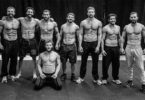Like a lot of my generation, I’ve devoted (probably) too much of my brain-time to thinking about the problem of what it means to be a superhero. Dressing up in spandex and patrolling the rooftops is, obviously, stupid. Apart from the danger, likelihood of getting arrested and unavailability of classic comic-book supervillains to punch, there’s the sheer inefficiency of it: you’re never going to see anything bad happening, and even if you did you could have probably spent that time better tackling root causes of crime, like social inequality and lack of education. Hear that, Batman?
So what is the definition of real-life superheroics? You could argue forever about this, but rather than do that I’m going to break it down to two things, and you can argue with me in the comments if you like. I think it comes down to:
- Changing the world for the better.
- Being brave about it.
And, as luck would have it, I’ve had the good fortune to talk to two people this year who fit the definition. They’re extremely different in aims and approach – but I think that, if you look at what they’ve done, you can see commonalities in the way they operate that are a) Helpful and b) Maybe the only way to actually get anything serious done. I’ll explain those at the end. First: the case studies.
Case study 1: The Real-Life Iron-Man
You might have seen Richard Browning in Wired, or giving TED talks, or hovering above the ground in any number of YouTube videos: he’s the guy attempting to revolutionise human flight by strapping miniature gas turbines to his limbs, like a real-life version of the Iron Man suit (early test runs look uncannily similar to Tony Stark’s prototypes from the films).
This isn’t just some tinpot project: with the tech he currently has available, Richard could fly thousands of feet in the air at hundreds of miles an hour – he just hasn’t done it yet, because he’s working on a way to make failures survivable. He’s now heading up a company of specialists in all the different areas that will drive the tech forward, polyurethane fuel tank expertise, radio frequency and welding expertise, from CAD design expertise to software engineering and aerodynamics experts, with patents on technology that has huge implications for aeronautics.
(Side note: if you’re reading this and going ‘Yeah, but is it actually good for the world?’ then please allow me to explain that Richard is also using the same mindset to develop tech designed to provide ultra-efficient solar energy to African schools by upcycling old car batteries – it just isn’t as immediately attention-grabbing as flying around in a rocket suit).
Anyway, I wanted to talk to Richard because, while everyone else was getting excited about the tech behind the rockets (how many PSi of thrust?!), nobody was actually asking him any interesting questions about his thought process or background in calisthenics, and the chat we had was fascinating – you can read most of it here. Key takeaways? Richard combined several years’ worth of training in calisthenics with a longtime interested in aeronautics to get to a point where strapping rockets to himself seemed like an obvious step, and now he can fly through the fucking sky. That, I hope you’ll agree, is awesome.
Case Study 2: The Game-Changing Campaigner
Earlier this year, Caroline Criado-Perez had two big wins within the same week, though they were years in the offing: first, the successful campaign to get a woman’s face (Jane Austen’s, in the end, though she’d have been happy with others) on British banknotes, and secondly the effort to get a statue of suffragist leader Millicent Fawcett in London’s parliament square, alongside the eleven other all-male political figures already there.
If you can’t see why this is important then Caroline has already explained it better than I can, but the TL;DR is that girls (and full-grown women) benefit from prominent role models: by being underrepresented in news, the media and culture generally, they grow up underestimating their own abilities, developing self-limiting beliefs that are both conscious and subconscious. If Caroline’s campaigning reminds thousands (millions?) of little girls that they’re just as competent and capable of political, scientific or cultural greatness as men, she will have made the world a better place.
Oh, and it isn’t irrelevant to point out that Caroline has put up with an awful lot of shit to do this: the Austen campaign, in particular, led to a sustained campaign of horrendous online abuse against her that included two people being jailed for making death threats. Women, generally, have to deal with exponentially more of this than men, and as a dude who’s only ever had to deal with a bit of mild online trolling (and hated it), I can only be impressed with how she coped. If you don’t think it’s especially brave, consider this: would you rather fly around with rockets on your feet, or have hundreds of faceless online avatars calling you awful names? I know which I’d pick.
Anyway. Hopefully you’re on board with this by now. Two potentially world-changing people, two very different approaches. What the hell do they have in common? I’ll tell you.
- You start from where you are.
- You do the first thing first.
Changing the world sounds like a nice goal, but it’s too big. How are you supposed to even get your head around it? Both Caroline and Richard worked with what they had, and started from where they were: Richard as a dude with stronger-than-average arms and a background in science, Caroline as a very smart woman with a decent set of contacts.
Richard wondered why it wasn’t possible to pursue human flight in a different way from the usual jetpacks and hang-gliders – and, because he had the sort of shoulders that could cope with an errant rocket engine yanking his arm the wrong way, hit on a solution most people wouldn’t have dared try. Caroline saw an imbalance in the way women were represented in British public life – in the Fawcett case, it was a jog through Parliament Square that prompted action – and decided to address it.
And then they both did something. For Caroline, it was setting up an online petition, then working with a solicitor to write to the Bank Of England, calling it out for falling short of a duty as a public body to ensure equality. For Richard, it was buying some aluminium tubes off Amazon and angle-grinding them together to make a prototype casing for an arm-rocket. The first thing, quite often, is the hardest thing: it’s the thing that gets things going, that takes you from an idea to a project, from ‘Wouldn’t it be better if…’ to ‘How can I make this happen?’ After that, the other stuff – having meetings with the director of notes at the Bank Of England, welding a jet engine to your new casing: that follows. It’s fine-tuning and keeping the momentum going. You can’t start by daydreaming about how cool it would be to fly around at a Red Bull-sponsored air event, or to have people telling you that their daughters learned about Millicent Fawcett today: you have to start with the first thing.
That’s my take, anyway. So here’s a challenge for you: whether you want to change the world, or just change yourself, start with what you have and do the first thing: the step you can take today that will lead to bigger, better things down the road. Use the skills you have, in the areas you’re interested in. Make things better. Change the world. Be a superhero.
Just don’t wear spandex. It looks stupid.
HOMEWORK: Grab a bit of paper and write down a huge goal you have, then make it smaller. Work back and back and back until you hit a first step you can take today. Do that step. And then do the next one. You’re on the way.





Inspiring, Joel! Just heard a TED talk on craftivism by Sarah Corbett. This is a quiet angle on doing big things. There is room for all of us to change the world.